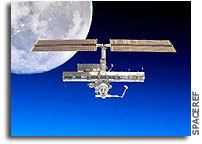NASA International Space Station Status Report 18 February 2005

The International Space Station crew is preparing for the arrival of fresh supplies aboard a Russian cargo ship. The seventeenth Progress to go to the Station is set to launch on Feb. 28 from Baikonur, Kazakhstan. It will dock with the orbiting laboratory March 2.
Expedition 10 Commander and NASA Station Science Officer Leroy Chiao and Flight Engineer Salizhan Sharipov are in the fifth month of a six month stay in orbit. The Progress cargo spacecraft attached to the Station will be undocked, reenter the atmosphere and burn up on Feb. 27.
This week several steps were taken to ensure all supplies are used from aboard the docked Progress before it is jettisoned. On Tuesday, Russian flight controllers fired the Progress engines for about seven and one half minutes, boosting the Station’s orbit by approximately two miles. Additional propellant was transferred from that craft into tanks aboard the Station.
Oxygen from tanks aboard the Progress is the primary method for refreshing Station cabin air. Several repressurizations of the cabin are planned to deplete those tanks before the craft is jettisoned. The Elektron, a device that normally generates oxygen for the cabin by recycling wastewater, has been intentionally turned off.
On Friday, Sharipov removed equipment associated with the Kurs automatic docking system from the Progress craft and stored it aboard the Station for reuse. Next week the crew will spend several hours stowing unneeded gear and trash aboard the Progress.
Other tasks completed by the crew this week included a semi-annual, thorough inspection of the special exercise treadmill. Over the course of several days, the crew partially disassembled the treadmill, which includes a special vibration isolation system to prevent exercise from disturbing sensitive experiments on the Station, to inspect its components.
All was found in good condition, except for the loss of one small, non-essential battery used to operate a timer.
Mission Control powered up the Mobile Base System, a type of rail car base for the Station’s robotic arm that allows it to move up and down the truss, to check its operation. Controllers found they could not receive video from a television camera mounted on a mast on the base system, nor would the camera respond to pan and tilt commands.
Engineers are evaluating the problem and planning possible troubleshooting. The camera is among several exterior Station cameras planned for use next week during a test of ground-commanded remote control of the robotic arm from Mission Control.
The Expedition 10 crew served as test subjects this week in a successful run of the Advanced Diagnostic Ultrasound in Microgravity (ADUM) experiment. Chiao set up the equipment. Chiao and Sharipov performed ultrasound bone scans and abdominal imaging on each other by taking turns as operator and subject. The bone scans were taken of the subject’s shoulder, elbow, knee and ankle, monitored remotely from the ground, videotaped and photographed for down link.
ADUM investigates the diagnostic capability of ultrasound in medical contingencies relevant to the space environment and demonstrates the ability of minimally trained crew members to perform and interpret advanced ultrasound examinations. The images are down linked to the ground for interpretation. This
“telemedicine” has important applications to emergency medical care in remote areas of Earth, as well as for astronaut crews traveling beyond low Earth orbit. The payload operations team at NASA’s Marshall Space Flight Center coordinates science activities on the Station.
Chiao and Sharipov took time out from their activities to speak with attendees at the European Space Agency Conference on Space in Brussels, Belgium, this week.
Information about crew activities on the Space Station, future launch dates and sighting opportunities from Earth, is available on the Internet at:
For information about NASA and other agency programs and missions on the Web, visit:








